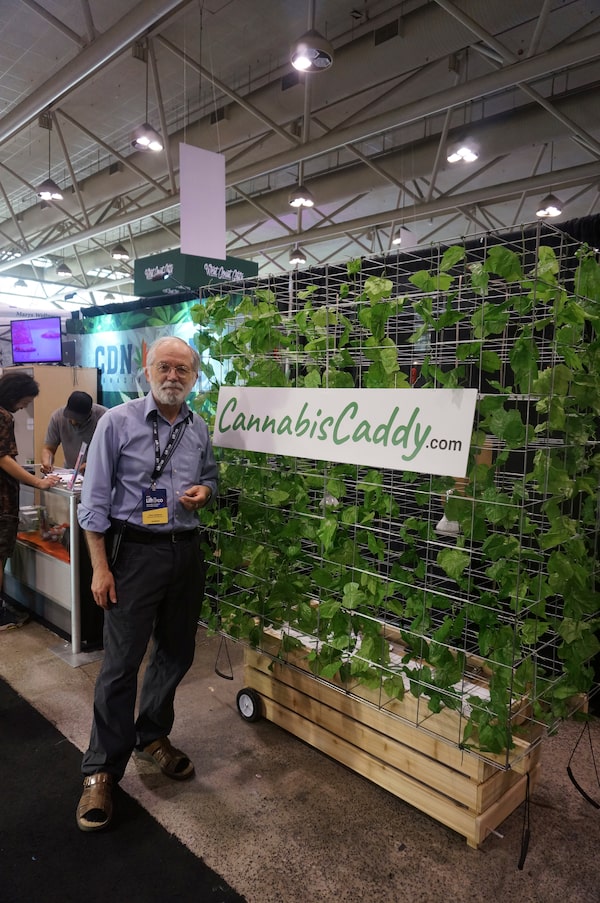
The Get Lit silicone pipe collection from West Coast Gifts.Ian Brown/The Globe and Mail
You could smell the weed that enveloped the Toronto convention centre a block away − and that was at 9 a.m. But it was the pitch contest that closed day one of the 2018 Lift Cannabis Expo last weekend that captured the Baby Huey state of Canada’s cannabis industry.
Legal recreational marijuana is coming (the government claims) by year end. But what will that look like? Will going mainstream dull the culture of cannabis − to say nothing of the weed grown by industrial weed farms? Or will the original anti-Establishment genes of cannabis rise up and resist mainstreaming? A surprising number of smart players are still asking this question. No one knows the answer.
The pitch contest pit three pot entrepreneurs against one another in front of a swelling crowd. Each presented a big idea to a panel of judges. The expo was organized by Lift & Co., which started life as a version of Yelp for pot smokers, reviewing strains of medical marijuana online, and is now a marketing network in the process of going public. The expo was Toronto’s third and biggest. Nearly 20,000 devotees showed up, at $20 a ticket. Some 260 exhibitors (up 30 per cent) inhaled 220,000 square feet in the main convention hall, 50-per-cent bigger than last year’s weedfest.
There was a lot to see and learn and touch, all of it entrepreneurial, from shining $1-million stainless steel cannabis-oil-extraction systems to the $500 wooden Cannabis Caddy, “the ideal gardening tool for personal-use growers.” Automated bud trimmers (28 pounds an hour, versus a pound an hour by hand) competed with makers of prerolled cones (a.k.a. joints and spliffs); Futurola’s desktop Knockbox II (US$4,500) can fill 1,000 cones an hour.

Futurola’s desktop Knockbox II.Ian Brown/The Globe and Mail
What else? Vape pens, which look like pens and allow for discreet odourless consumption and (more importantly) account for a head-straightening 15 per cent of cannabis industry sales; aquaponic and lighting systems up the wazoo; Hawthorne Gardening, the cannabis-related arm of Scotts Miracle-Gro, the American lawn and garden giant whose CEO Jim Hagedorn has spent nearly US$1-billion over four years to acquire cannabis-related businesses (he has also mused publicly about GMO cannabis and maintains close ties to Monsanto); growers such as Indiva, in London, Ont., which also sells cannabis-infused sugar and salt. Which reminds me: Cannabis coffee − your morning java jived with a dollop of cannabis-laden coconut oil − is the coming thing. You read it first in The Globe and Mail.
Explainer: Marijuana legalization: How Canada is planning on regulating recreational cannabis
*****
The first pitcher was a biologist in his 20s named Kevin Chen. He had a man bun and was as slim as a tie pin. His company, Hyasynth − someone is going to write an academic monograph on corporate nomenclature in the early days of the pot business − makes cannabidiol (CBD) out of yeast. Cannabidiol is the compound that gives cannabis its vaunted medical benefits (relief from anxiety, inflammation, pain and seizures, for starters) without making you psychotropically high, as cannabis’s other main component, THC, does.
(Am I going into too much detail here? I don’t mean to, but in the cannabis “space,” where many participants are daily microdosers, everyone talks incessantly and veers into endless if fascinating detail. Saying hello can take five minutes.)
Where was I? Oh, right: yeast. Hyasynth alters the DNA of industrial yeast and then ferments new stuff out of it. (The same basic process is why we no longer have to kill pigs to make insulin for diabetics.) The company has already bubbled up 20 kilograms of pure CBD, which is worth about $2.5-million. Mr. Chen wanted $10-million to scale up.
The second pitcher was an Englishman, Mat Fogarty. He was a handsome guy of 48 wearing a tailored blue suit and a tie. He also has a degree from the London School of Economics and an MBA from Berkeley, and worked for Unilever and in the tech business in Northern California, where he currently lives.
His brainwave was the Can of Bliss, a pocket-sized resealable weed tin. A brilliant pitchman, Mr. Fogarty admitted he smokes several times a day and needs weed with him. (“I used to smoke a lot of weed,” he later told me, “and would then stop and lay off it, and then start and stop again, trying to maintain a balance of yin and yang. But then I realized, I just want all yin, all the time.”)

The Boss, an extraction machine made by Canada’s Quadron Cannatech Corp. that uses CO2 to extract cannabis oil from the clippings left behind when a bud is trimmed.Ian Brown/The Globe and Mail
Mr. Fogarty said his tin − white, with black type and gold edging, “so much more beautiful than a sealable bag” − gives his nugs of bud a shelf life of three years, versus three weeks in your freezer or underwear drawer. And it was infinitely preferable to a glass Mason-style jar, the pot connoisseur’s conventional vessel of choice. “Typically, you want to choose the small nug, and leave the big nug for later. In a vertical jar, the small nugs are the hardest to get. Instead of going vertical, you should go horizontal.” Hence the tin. “In a way, it was one of the most important insights I had.”
The cans are premade in China and then laser-printed and filled in a machine built into a shipping container. Mr. Fogarty’s plan is by 2020 to have 20 containerized machines in 20 pot-producing regions, where his representatives will select the best “grower-graded” microgrown craft cannabis, then tin it and label it on-site, as a Can of Bliss varietal. The machine can wind out 40,000 tins a day.
The judges had a few questions. Was the tin childproof? Yes. Did it comply with Canada’s draconian pot-labelling restrictions? Yes.
Mr. Fogarty made it clear he wasn’t just selling a can: He was selling a brand, Can of Bliss, that “could be the No. 1 brand of cannabis in the world,” the way Coca-Cola (which is bottled where it is sold) became the No. 1 brand of soft-drink worldwide. “It’s not just a can,” Mr. Fogarty enthused. “I don’t want to sell the can. I want to sell the whole experience. We’re selling something that’s intangible.”
The third contestant was Kit Poon, a slight but trim owner of 13 pharmacies in Alberta. Mr. Poon was pitching an algorithm designed to bridge the gap of trust between cannabis users and doctors. A patient looking for pot would complete a survey − age, ailment, allergies − whereupon the algorithm would recommend three different brands of cannabis and send an e-mail to the local pharmacist.
“The algorithm would smooth out the process,” Mr. Poon said. What just a few years ago was an individual, private process − obtaining pot − becomes, with Mr. Poon’s algorithm, a human-free process. It was, in form and spirit, the very opposite of Mr. Fogarty’s proposal.
*****
Throughout the convention, everyone engaged in an endless train of panel discussions.
One frequent topic was the challenge of investing in the overvalued (and, some say, overcapacity) cannabis industry. “This is a trader’s market, not an investor’s market,” insisted Tracy Weslosky, CEO of InvestorIntel Corp. Another was the difficulty of marketing pot when the federal government wants cannabis packaging to be no more alluring than a body bag.

The Futurola booth at the Lift & Co. Cannabis Expo in Toronto.Ian Brown/The Globe and Mail
The experts also revealed the hottest new trends in cannabis: the use of cannabis before, during and after exercise, and − this from Erin Johnson at Province Brands of Canada, which is trying to develop cannabis cocktails − “seeing friends and family switch from alcohol to cannabis.” In Colorado, Oregon and Washington, where marijuana is legal, beer consumption is down 5 per cent in two years.
*****
The judges gave the win to Mr. Fogarty. The yeast idea had a yech factor, and Mr. Poon’s algorithm was impractical.
Mr. Fogarty was delighted. His win struck a blow for a bespoke product, for the small, the handcrafted, the personal − values that have been steamrolled as industrialized cannabis production has taken the lead in the run-up to legalization.
Cannabis has been a symbol of resistance for at least 150 years in the Americas alone − a way to step away from conformity and the rules of the Establishment, if only for a few hours on a Saturday afternoon.
Now, the Establishment has swallowed cannabis whole. Cannabis is so mainstream, an increasing number of banks are backing it. Users are excited by the possibilities legalization offers − access, variety, quality, research, the chance to go legit − but many are concerned that making pot big business will screw up and even debase the experience. “The danger is that Bay Street will forget about Main Street, and Main Street won’t want to have anything to do with Bay Street,” Abi Roach, the owner of Toronto’s storied HotBox Cafe and a judge in the pitch contest, explained.
The good news is that the lurking ghost of pot’s rebellious past has already rematerialized. At the other end of the vast convention hall, Jen Newton, a branding specialist, and her pot podcast partner Michelle Bilodeau (“a writer and momma who smokes weed”) were sparklingly clear about where the subversive energy of cannabis is headed − toward women.

The Cannabis Caddy, for personal backyard growing, with its inventor, 67-year-old Peter Kielland.Ian Brown/The Globe and Mail
Emerging evidence suggests women may consume more cannabis than men. A 2017 Cannabis Consumers Coalition study found 58.4 per cent of women use cannabis, versus 41.7 per cent of men. Sixty per cent of those women consume it every day, whether psychoactive THC or (more often) calming CBD. Ninety-one per cent of them smoke two to three times a week.
There are polls that contradict these claims, but their sample populations have been faulted for being male-heavy.
“Women have woken up to the heavenly holistic,” Ms. Newton said. “We are the mystics who are driving this category forward.”
But as Ms. Newton, Ms. Bilodeau and their guest, trend researcher Carly Stojsic, point out, it’s a development women have been slow to admit to − and that the male-dominated industry has almost ignored. “More women are worried about stigma than about legality,” Ms. Newton says of her gender’s reticence. “It’s judgment. Will my family judge me if I smoke cannabis? Will my husband judge me? Will I be thought of as less intelligent?” In fact, “cannabis lets you engage with what’s right in front of you.”
Maybe the restive draw of cannabis runs even deeper for contemporary women of the #MeToo era.
Nevertheless, the trio says, fewer than 5 per cent of boardroom seats at Canada’s cannabis companies are occupied by women. Products such as CBD, which many women prefer, are underplayed − “because,” Ms. Stojsic says, “everything is concentrating on the consequences of the THC.” One result is the cannabis world’s persistent (but inaccurate) reputation as a hangout for dopehead stoner guys.
Hence one of the purposes of the 2018 Lift convention − what Ms. Newton calls “the deskankification of this category. This is a female plant that is ruling the world.” That would be a real revolution.
Editor’s note: An earlier version of this article included an incorrect name for the third contestant. He is Kit Poon, not Ken Koon as published. This version has been corrected.